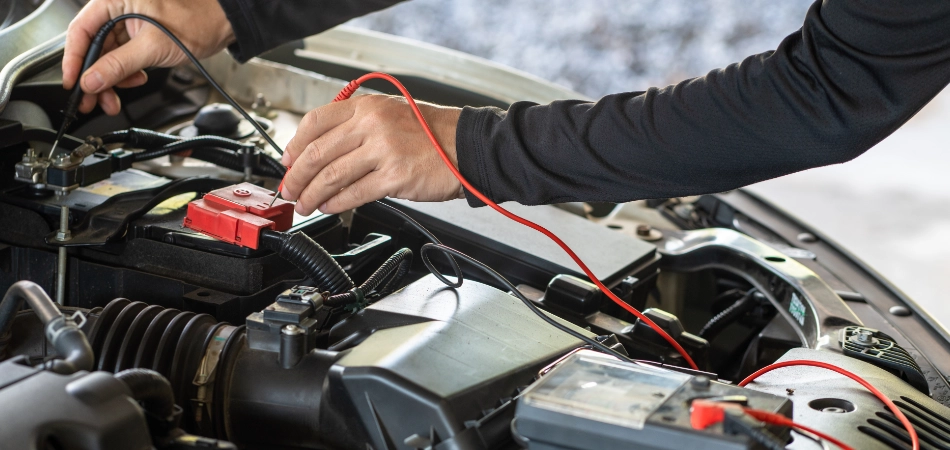Guide to a Car Battery Health Check

No battery, no trip to the supermarket, commute to work, or any of the thousands of little expeditions you take for granted.
Minus a healthy battery, a car won’t start unless you’ve got a good set of jumper cables and a donor car to provide a charge. And then what happens at your next stop?
A poorly maintained battery can lead to:
- Sudden failures that leave you stranded.
- Reduced lifespan, costing you money in replacements.
- Decreased vehicle performance, including dimmed headlights and slower engine starts.
Regular health checks ensure your battery remains reliable and extends its lifespan. Plus, with the right tools and know-how, inspecting your car battery is neither time-consuming nor complicated.
Signs Your Car Battery Might Be Failing
Look for these signs that your battery may be on its way to Gloryland:
- Your car struggles to start and cranks slower than usual.
- Headlights, dash lights, or interior lights appear dimmer.
- Issues with the car’s radio, power windows, or other electronic devices.
- The battery or check engine light appears on your dashboard.
- Visible corrosion and crusty residue around the terminals.
- Age – if your battery is over 3–5 years old, it’s probably nearing the end of its lifespan.
Tools You Need for a Car Battery Health Check
Your toolkit should include:
- Digital multimeter to measure voltage.
- Battery load tester (optional but helpful) to assess battery performance under load.
- Protective gear like safety goggles and gloves.
- Cleaning supplies: Baking soda, water, a wire brush, and a clean cloth.
If you don’t have all these tools, a simple visual inspection combined with a multimeter test is enough to start you off.
Step-by-Step Guide to Checking Your Car Battery
1. Perform a Visual Inspection
- Look for corrosion (whiteish or bluish build-up) around the terminals.
- Check for cracks, leaks, or bulging in the battery casing, which can indicate a failing or hazardous battery.
- Inspect the battery cables for fraying or loose connections.
If you see any of these issues, it might be time to clean and secure the battery or consider replacing it.
2. Measure the Battery’s Voltage
Using a digital multimeter:
- Set the multimeter to DC voltage mode.
- Turn off the car and switch off all electronics.
- Place the red lead on the positive battery terminal (+) and the black lead on the negative terminal (-).
- A healthy battery should read between 12.6 and 12.8 volts when fully charged (with the car off). If it’s below 12.4 volts, the battery might need recharging or replacement.
3. Conduct a Load Test (Optional)
If you have a battery load tester:
- Connect the tester to the terminals while the battery is still in the car.
- Turn the vehicle’s lights or ignition on briefly (without starting the engine).
- A healthy battery should maintain a voltage above 9.6 volts under load. The battery may struggle to power your vehicle if it dips significantly lower.
4. Check the Battery Electrolyte Level
For batteries with removable caps:
- Carefully remove the caps and inspect the electrolyte level in each cell.
- The level should cover the metal plates inside. If low, add distilled water (not tap water).
- Wear protective gloves and goggles during this step to prevent accidents.
5. Test While the Engine is Running
- Start your vehicle and test the voltage again with the multimeter.
- A healthy charging system should read between 13.7 and 14.7 volts. Below this range might indicate an issue with the alternator or charging system.
6. Clean & Secure the Battery
Finish the inspection process by cleaning and tightening connections:
- Neutralize and remove corrosion with a wire brush and a paste of baking soda and a little water.
- Secure all cables tightly to ensure good electrical contact.
How Often Should You Check Your Car Battery?
- Every 3 months or at the change of each season to align with temperature fluctuations.
- If your car shows any of the early warning signs listed above.
- Right before long road trips, to reduce the chance of mishaps.
Common Car Battery Mistakes to Avoid
- Skipping routine checks. Waiting for it to fail is a costly mistake.
- Using tap water to top up electrolyte levels can damage the battery.
- Ignoring corrosion on battery terminals, which can disrupt connections.
FAQs: Car Battery Check
Q: How do I know if my car battery needs to be replaced?
If your battery is over 3–5 years old, struggles to maintain a charge, or frequently dies, it’s time to replace it.
Q: Can I check my battery health without tools?
While tools like a multimeter give precise results, you can perform visual inspections or observe signs like slow starts and dim lights.
Q: How can I extend the life of my car battery?
Key practices include regular maintenance, cleaning terminals, avoiding frequently draining the battery, and driving your car regularly.
Q: What’s the best time of year to check my battery?
Check your battery at the start of summer and winter, since extreme temperatures can affect performance.
Q: Can I jump-start a car with a dead battery?
Yes, but frequent jump-starting can stress your battery and alternator. If the battery repeatedly fails to hold a charge, consider replacing it.
Q: What damages a car battery the most?
Frequent short trips, leaving electronics running while the car is off, or exposure to extreme temperatures can wear out a battery faster.
Q: What is a maintenance-free battery?
Maintenance-free batteries are sealed and don’t require you to check electrolyte levels. However, they still need regular voltage checks.
Q: Should I disconnect my battery if I’m not driving my car long?
Yes, disconnecting it or using a battery maintainer can prevent it from draining completely during lengthy periods of inactivity.
More Articles

0 Comments